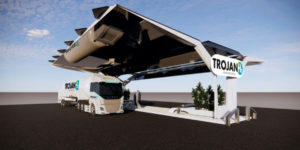Trojan H2 Logistics leads the hydrogen transport revolution
Energy
Energy
Trojan H2 Logistics is striking deals that place it at the forefront of the lucrative hydrogen transport market.
PwC estimates the total domestic infrastructure investment required to store, transport and distribute hydrogen to take full advantage of Australia’s opportunity to become the dominant East Asian exporter could be up to $80 billion by 2030.
And Trojan is already streets ahead of the competition, carving out its position as Australia’s very first molecular storage, haulage and distribution company.
With the acceleration in the establishment of hydrogen hubs around the country comes the need for a secure, reliable and affordable logistics solution to transport hydrogen.
To help meet this growing as-yet unmet need, Trojan has executed two separate deals with major industry suppliers.
Trojan has signed a memorandum of understanding (MoU) with suppliers for the delivery of 100 LH2 Fuel Stations, as well as a $US2.8m ($3.6m) agreement to immediately acquire 2 ADR-approved liquid hydrogen trailers capable of holding around 55,000 litres, or nearly 4 tonnes.
This is expected to be the start of a planned 1,000 strong fleet of H2 trucks to be rolled out Australia-wide.

Meanwhile, Trojan has also signed an MoU with a second industry leading supplier for the supply of 50 hydrogen prime movers.
The company has every intention of buying another 1,000 trucks if demand continues to remain strong.
This supplier is currently producing heavy trucks capable of loading 50 tonnes at a time. The industry leading hydrogen fuel cells powering the vehicles allow for a 600-800km driving range per refuelling.
PwC says the global hydrogen market is expected to “boom” between 2030 and 2050.
In Australia, the largest end uses for hydrogen will be as a blended gas and as a transport fuel, but there are many other investment opportunities across numerous sectors, according to PwC.
In particular, Japan and South Korea represent a multi-billion-dollar opportunity for the Australian export industry over the longer term thanks to their ambitious hydrogen targets.
By PwC’s figures, global demand for hydrogen currently amounts to about 70 million tonnes, primarily for use in oil refining and ammonia production for fertilisers. The hydrogen market is currently worth about $US135 billion.
That global demand is forecast to increase to 100 million tonnes by 2030 and surpass 500 million tonnes by 2050.
But right now, global hydrogen production is largely derived from fossil fuels (natural gas or coal), a process which creates large amounts of CO2 emissions and is tagged ‘grey’ hydrogen.
But governments around the globe have set their sights on ‘green’ hydrogen as a key contender in the clean energy mix as they strive to hit their zero emissions targets.
Green hydrogen is produced from renewable energy sources via the electrolysis of water and is completely carbon free, or from other renewable sources like biomass.
Goldman Sachs previously estimated that green hydrogen could supply up to 25 per cent of the world’s energy needs by 2050, making it a $US10 trillion market globally.
But green hydrogen requires transport infrastructure that provides stability, minimises losses, is efficient and affordable.
For domestic transport, hydrogen is expected to be transported by pipelines – either newly built or modified existing pipelines – or via storage and transport of hydrogen in the form of gas, liquid or fuel cells.
This article was developed in collaboration with Trojan H2 Logistics, a Stockhead advertiser at the time of publishing.
This article does not constitute financial product advice. You should consider obtaining independent advice before making any financial decisions.